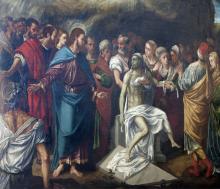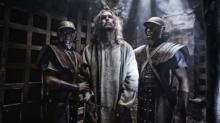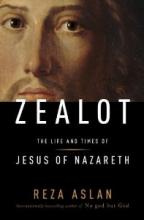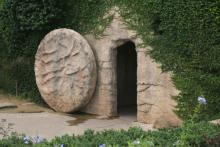resurrection

At Easter, Christians celebrate Jesus’ rising from the dead. But in light of new revelations of the CIA’s abhorrent acts of torture, it’s the United States that needs resurrection, too.
Details of the CIA’s post-Sept. 11 torture campaign — made worse, if that is possible, by evidence of official deception — are described in key portions of the report on CIA-sponsored torture that the U.S. Senate Intelligence Committee voted last week to release.
Though the public has not yet seen the report, current and former U.S. officials who have read it have disclosed information to The Washington Post, Human Rights Watch, and other sources that ought to disturb all of our consciences.

Easter Sunday marks the holiest, most exalted moment of the Christian year. In Easter services all over the world, trumpets and organs blast. Flowers transform churches with their brightness. Worship leaders boldly proclaim: “Christ is risen!” Congregations echo back: “Christ is risen indeed!” The cycle of celebration and repetition begins as it should — a festive proclamation of good news. In Christ God has overcome the powers of sin and death, freeing us to live with hope and promising us life. Not just life after death, but full life, divinely inspired life — life in the here and now.
Christ is risen! Christ is risen indeed!
Even in these festive moments, many people express insecurity regarding the quality of their own believing.

As we approach Holy Week, I’ve been re-reading the Gospel accounts of Jesus’ Last Supper, trial, crucifixion, and resurrection. In John 17, as Jesus prays for his disciples and their successors in the hours before he is arrested, he prays for our unity as his church:
…that all of them may be one, Father, just as you are in me and I am in you… May they be brought to complete unity to let the world know that you sent me and have loved them even as you have loved me. (John 17:21, 23)
Central to our mission as Christ’s followers is to share with the world this good news: that the Father sent the Son because he so loved the world — but the best observable evidence of that Gospel reality, a unified Church, seems a distant, utopian dream. Just within the United States — this small sliver of the global church — we are divided by denomination, by race, by political ideology, and by the competitive human instinct that leads even those congregations who resemble one another doctrinally, ethnically, and politically to jockey over the same individuals in order to fill their sanctuaries (or auditoriums) and offering plates. Perhaps the situation is not quite so stark: I know that many — probably most — believers share the desire for unity. It just seems at times that we have so far to go, and might be drifting in the wrong direction.

Editor's Note: This post is adapted from a sermon preached by the Rev. Dr. Randle R. (Rick) Nixon.
Some of us have stood at a tomb, faced an open grave, scattered the ashes of one beloved. We know what it’s like to be confronted with the stark reality of death and the flood of conflicting emotions that comes with it. I’ve stood at different sites at Dry Creek Cemetery in Boise, Idaho, and the Veteran’s Cemetery next to it, to bury my father, my brother, my nephew, my step-father and-step sister, my brother-in-law, not to mention my beloved piano teacher, and a dear high school friend. Not so long ago I stood by the open grave of Patrice Heath as her casket was lowered into the ground. We prayed and wept and celebrated her life, but it is not an easy thing, under any circumstances, to lay a loved one to rest.
The ancient story of Lazarus being raised from the dead in John 11:1-45 is just such a situation. It’s also another occasion to encounter Jesus in his divinity and his humanity. It’s a long, complicated story. You have heard it read. I will not attempt to unpack it all.

THERE IS NO controlling a story once it’s out. Even in the times before cell phones, the internet, and Twitter, news traveled a similar route through participants, eyewitnesses, and those with the privilege to eavesdrop upon rumors and reports. Details get scattered, but the facts stand out. Many stories can be told about who, when, and how the story leaked. But all those specifics remain secondary to the spectacular announcement. For example, in 1903, how did The Virginian-Pilotscoop other newspapers to be the first to cover the beginning of the aviation age? No one really knows. Orville and Wilbur Wright believed their hometown Dayton newspapers should make the announcement. Indeed, on Dec. 18, the day after the first flight, the Dayton Evening Heraldreported the news—directly based on a telegraph sent by Orville Wright. But three other papers had already reported this world-changing occasion based on TheVirginian-Pilot’s story. Though filled with inaccuracies, the original accounts correctly announced the single important fact: There had been a flight!
Two thousand years earlier, the witness of a few women called forth centuries of testimonies that describe a progression from lack of recognition to full recognition of Jesus the person, as well as the significance of his death and resurrection. The cross and the empty tomb are not self-explanatory; they require interpretation. On the other side of the Lenten journey, Easter provides opportunities for the church to reflect on the biblical witness concerning the rumors of the resurrection. These texts highlight not only the necessity of interpretation, but also the sources and shape of valid interpretation.

Yes, his blood was on us once,
making us famous blades within the blades
community. I mean, many of us
had taken blood and sweat before
from lions and dogs and even fallen birds
or lovers and killers and the killed
but this was the first time we took both
at the same time, from the same creature.
You humans have that saying,
Blood, sweat, and tears. By this you signify work.
Consider the lilies of the field, he said
of our cousins. They neither work nor spin
but I tell you that not even Solomon
in all his glory was clothed like them.

There is certainly a warm, nostalgic feeling about the Christmas season. Social media fill up with pictures of Starbucks holiday cups and we get the play-by-play of Christmas trees being purchased and filled with homemade ornaments. Holiday parties become about as frequent as breathing and there is a general sense of camaraderie among people who wouldn’t otherwise interact.
As a local practitioner and neighbor, I’d even go as far as saying this season brings about the most opportunity for new relationships and shared life in the realities of everyday.
Last week I was talking to my 3-year-old daughter about Christmas. She knows we are going to see grandparents and cousins and even knows a thing or two about gifts being exchanged.
And then I asked her, "Whose birthday do we celebrate on Christmas?" With a big smile, she said, "Santa!"
Now, I get it. She’s 3 years old, it’s kinda cute and harmless and whatever.
But there is something to this.
Our family never talks about Santa Claus, but we regularly talk about Jesus and even go as far as trying to live like him as best we can. When we do talk about Christmas and presents, we try to talk about how we will be giving them away to friends, family, and people who need them.
But, despite our best efforts, Christmas is associated with Santa Claus. Now, if it were the historical “Santa Claus” who gave away his best to save the lives of some children, that’d be awesome. But, no, this is the Santa Claus of consumption who promotes values of selfish acquisition rather than sacrificial giving.

Studios and filmmakers are rediscovering a classic text as source material for upcoming mainstream films: the Bible.
Nearly 10 years after the blockbuster success of Mel Gibson’s “The Passion of the Christ,” which earned $611.9 million worldwide, studios are looking to the Good Book for good material.
Alongside the string of upcoming Bible-related films, producers from the History channel’s “The Bible” miniseries just announced that the series’ film adaptation “Son of God” will be released in theaters nationwide in February with 20th Century Fox.

THE CELEBRATED PHILOSOPHER Ludwig Wittgenstein used to speak—disapprovingly—of “language going on holiday.” For example, sportswriters often free language from the drudgery of everyday common usage to let it spread its wings in glorious hyperbole about their favorite teams.
Our biblical heritage gives us examples that are much deeper. When we read the prophets especially, we hear language liberated from the constraints of the everyday to give it a sacred vacation, a true “holy-day,” so that it can return to us reinvigorated. We hear them sending language on an adventure holiday into the realm of God’s future. When they receive the words back, the prophets find themselves recounting visions of a new world that God has in store.
Eschatological language that has been to the future and back exerts a powerful authority over us. In this month’s scriptures we experience that authority again in Isaiah’s unforgettable oracles about the holy mountain on which no one shall ever again hurt or destroy. We shall see, with our mind’s eye, the rising of the sun of righteousness with healing in its wings. We shall hear Jesus speaking of the life waiting for the children of the resurrection. The church’s year ends by inviting us to enter under the authority of the coming kingdom, to become fluent in its strange language of hope, harmony, and ultimate reunion with the Holy One who has reconciled all creation through the cross and resurrection.

Reza Aslan begins of his book, Zealot: The Life and Times of Jesus of Nazareth, with a prescient warning: “Scholars tend to see the Jesus they want to see. Too often they see themselves—their own reflection—in the image of Jesus they have constructed” (xxxi).
I don’t think Aslan had himself in mind when wrote that statement, but you should be warned: the Jesus in Zealot is Aslan’s own false construction.
His central thesis is that the Jesus of history, and the God Jesus believed in, demanded violence in the face of political and religious oppression. Here’s one of the relevant passages:
[F]or those seeking the simple Jewish peasant and charismatic preacher who lived in Palestine two thousand years ago, there is nothing more important than this one undeniable truth: the same God whom the Bible calls a “man of war”(Exodus 15:3), the God who repeatedly command the wholesale slaughter of every foreign man, woman, and child who occupies the land of the Jews, the “blood spattered God” of Abraham, and Moses, and Jacob, and Joshua (Isaiah 63:3) the God who “shatters the heads of his enemies,” bids his warriors to bathe their feet in their blood and leave their corpses to be eaten by dogs (Psalm 68:21-23)—that is the only God that Jesus knew and the sole God that he worshipped. (122, emphasis in the original.)
The problem that I have with this passage is indicative of the problem that I have with the way Aslan constructs his Jesus. He constantly picks and chooses which verses from the Bible he uses to support his claim that Jesus was a warrior messiah whose goal was to violently overthrow the Roman and religious establishment. He peels away all passages that conflict with his construction so that he can show us what Jesus was truly like.
Well, what Aslan thinks Jesus was truly like.

How’s this for an unlikely scenario? One of the characters in Keith Huff’s new crime comedy, Big Lake Big City, is a petty criminal named Stewart who ends up not quite dead after a screwdriver accidently gets embedded in his skull. If the doctors try to remove it, he will die; if they leave it in, he will die. But somehow he isn’t dead yet. For a few days he walks around in a liminal space between life and death, more like a walking corpse than anything else. The sign of his violent demise is there for all to see but he manages to hide it under a Shriner’s cap. A pretty funny sight gag because you have to ignore that fact that the hat is kinda floating off kilter slighter off his head in order not to know something is terribly wrong.
Big Lake Big City is having its world premiere at Lookingglass Theater in Chicago this summer. After seeing the show and interviewing the lead actor Phil Smith for Voices of Peace Talk Radio here at Raven, I couldn’t help but see parallels to another unlikely scenario: a crucified man is resurrected with the marks of his violent death on his body for all to see. I’m pretty sure that Keith Huff did not intend to write a Christian allegory, but the themes of life, death, and resurrection reverberate through the play. Oddly enough, I think Stewart’s story can function as a parable of sorts for understanding the radical shift in the human relationship to death and violence that was made possible by the resurrection. Stay with me, now!

… suffering produces endurance, and endurance produces character, and character produces hope, and hope does not disappoint us.
-Romans 5
As many of you know, I have a regular spiritual practice of warning people that I will disappoint them. A couple times a year, we host a Welcome to House for All Sinners and Saints brunch for newcomers. Everyone goes around the room saying what drew them to this community or what keeps them here. They usually say it’s a comfortable place where they can just be who they are or they love the singing or the community. One time someone said that their mom was Catholic and their dad was atheist and that this church kinda felt like a combo of the two. And while I wasn’t entirely sure I knew what that meant, I thought it was awesome.
Well, I usually am the last to speak at these events and when I do and I always say how great it is to hear all of that, but that I need them to hear something. And that is that this church will disappoint you. Or I will fail to meet your expectations, or I’ll say something stupid and hurt your feelings. It’s not a matter of if it’s when. Welcome to House for All Sinners and Saints. We will disappoint you.

THE SAGA OF Elijah that we are following in 1 and 2 Kings culminates in a poignant parting as the prophet prepares to be taken up into heaven. His disciple, Elisha, makes a final all-or-nothing request: “Please let me inherit a double share of your spirit” (2 Kings 2:9). Elijah states a condition for the fulfillment of Elisha’s prayer: “You have asked a hard thing; yet, if you see me as I am being taken from you, it will be granted you; if not, it will not” (2:10). It is as if Elisha has to look unblinkingly into the reality of their separation. If he is to inherit the prophetic mantle and spirit of his teacher, he must claim the vocation in its entirety. He is now to be the prophet.
The story is an uncanny pointer to the truth that John the Evangelist highlights in Jesus’ last words to his disciples: “I tell you the truth: It is to your advantage that I go away, for if I do not go away, the Advocate will not come to you ...” (16:7). John even echoes the “double spirit” theme in 14:12, when he has Jesus assure us that our prophetic endeavors will be more abundant and powerful than Jesus’ own!
The season following Pentecost helps us realize that we are the prophets now, vested with the mandate and endowed with the gifts for enacting the good news of liberation.

We tend to consider the crucifixion, the resurrection, and Pentecost in two ways primarily. We see them as history, stories about things that happened a long time ago. Or we consider them through theologies about what they mean for us after we die.
Yet, there is a deeper reality to all of them. The cross, the empty tomb, the moment of divine inspiration are repeated every day and everywhere. They’re ongoing and participatory.
Many experience those moments of inspiration each day. They’re moved to help someone who is hurting, inspired to care for those who are struggling, emboldened to try to change their world in some way. They sense something divine in the small moments of life. They stand up for anyone who is being treated as less than an equal child of God. They see love at work all around them.
Spirit-filled moments happen every day.

At the Full Frame Film Festival in Durham last week, I saw Marco Williams’ new documentary, The Undocumented, which tracks migrants as they hike into the United States across the border between Mexico and Arizona, trying to escape the detection of border patrol agents, and trying to survive the deadly heat of the Sonoran desert.
The documentary follows a young man, Marcos Hernandez, as he tries to find his father, Francisco, who was last seen in the desert walking for days in the 120-degree summer heat. Francisco left their home in Mexico with a coyote — man he paid $2,000 to lead him across the border — to make enough money to pay for his son’s expensive dialysis treatments. But he never called; he never returned. The coyote reported that he left Francisco in the desert because he was sick and couldn’t keep up with the other migrants in the group. Marcos fears the worst — that his father died of dehydration, of heat exhaustion. But to confirm the death he has to find the body.
The filmmaker focuses on the morgue in Tucson, Ariz., where the medical examiner investigates human remains, looking for clues that would help identify the dead in order to return whatever is left to family members and friends, to provide some kind of closure, to honor the dead with a burial.
In the film, Marcos won’t believe his dad is dead until he can see his dead body, or whatever is left of his body — a skull, teeth, his rib cage. He will not believe unless he can see.
“Unless I see the mark of the nails in his hands, and put my finger in the mark of the nails and my hand in his side, I will not believe” (John 20:25). That’s what Thomas says to the other disciples about the resurrected Jesus; and what Thomas says about needing to see the body reminds me of the story of Marcos, about the need to see in order to believe.

Immediately following the election of Cardinal Jorge Mario Bergoglio as Pope came the predictable speculation. From the United States and other wealthy nations, folks wondered what the new Pope would say about issues related to gender and human sexuality. What about birth control, homosexuality, and women’s leadership in the church? Did the new Pope really support civil unions for gay and lesbian couples in Argentina, as some reported? Others, including many from Latin America, Africa, and parts of Asia responded to Pope Francis’ commitment to a simple lifestyle and his commitment to economic justice. While some fretted about his relationship with the Argentinian military dictatorship during the 1970s and 1980s, most have been impressed with his social witness. In one of his first public acts, Pope Francis entered a youth detention center in Rome and washed the feet of young offenders.
Lots of observers might wonder, “Why is the church expending so much energy on controversial social issues? Shouldn’t the church focus on spiritual matters rather than concerns of the flesh? Why does the church need to meddle in matters that lie beyond its purview?”
The Easter stories offer a direct answer. Whether we agree with the Pope or not, Christians care about human bodies. The resurrection story implies that bodies matter. Jesus’ resurrection is not merely a spiritual thing – the apparition of his ghost, or his ongoing spiritual influence. The Gospels all insist that the resurrection includes Jesus’ body.
In some way or other, I think it’s safe to say that we all have a kind of nostalgia for the innocence and purity of the Garden of Eden before what we call “the fall.” We have a sense that we are not supposed to be outside the gates of the Garden … out here. At the expulsion of the man and the woman in the story from Genesis, the cherubim (angels) are posted at the gate to be sure that those who have been expelled cannot get back in. The cherubim and a twirling, flaming sword keep Adam, Eve — you, me, all of us — on this side of the gate, outside the Garden of Eden.
Well it’s a story, of course, but isn’t it our story? Nostalgic for a world where nothing ever goes wrong. But illness comes, a marriage goes bad, a relationship with someone you love falls apart just when you think it’s to lead to something more permanent, you lose a job, you suffer depression, you suffer from an illness, you’re left alone in grief over the loss of a loved one. Or you yourself are dying, and there are wars and rumors of wars. We watch the children and wish that we could protect them, but we can’t, even though we are parents and grandchildren, aunts and uncles. Out here, outside the Garden, it’s rough sometimes.

(The Controversial figure Rob Bell has created another firestorm with his latest provocative book What We Talk About When We Talk About God. Raven Foundation Education Director, Adam Ericksen and Tripp Hudgins will share our thoughts on the book in this blogalogue. We invite you to join the discussion by leaving a comment below.)
Tripp Hudgins always gets me thinking. He is right that Rob’s chapter “Open” in What We Talk About When We Talk About God is about science and religion but that it’s also not about science and religion. This is the longest chapter of the book, and it’s full of scientific information that points to the mystery of the material world. What’s the point? As Tripp states, Rob is “asking for a little humility. He’s asking for a little poetic imagination. He’s asking for curiosity.”
That’s the point of the next chapter, too. Titled “Both,” in this chapter Rob points out a major problem we have with “God-talk.” That problem is language. Tripp set me up for this at the end of his post by asking, “Are words actually enough? Ha! Write about that. Words. Words. Words.”
When I was in seminary I learned about apophatic theology, or negative theology. It tries to define God by what God is not. A 9th century apophatic theologian named John Scottus Eriugena asserted, “We do not know what God is. God Himself does not know what He is because He is not anything. Literally, God is not because He transcends being.”

For the sake of the world, we should all be feminists. And given what we know about the role of independent, empowered women in the community of disciples, for the sake world, we might be “Christians.”
Raymond Brown, the late, great scholar of John, writes: “In this Gospel, where light and darkness play such a role, darkness lasts until someone believes in the risen Jesus.”
Therefore no darkness, no heartbreak, no grief, no injustice can long stand where the Risen Christ is proclaimed. Jesus Christ is the light of the world. The light shines in the darknessa and the darkness does not — cannot — will not overcome the light.

In Christianity’s passage through Holy Week to Easter Day, a moment of truth will arrive.
Every detail is well known, thoroughly studied, and dramatized by Hollywood and homespun pageants — and the familiar story will reach across the divide and touch, or try to touch, every person who is listening and watching.
Many will get it, especially if they live in circumstances where people get falsely accused by the self-righteous; where the weak and vulnerable get mistreated by the powerful; where physical suffering is a daily occurrence; where death seems like the only next option.
That audience could well comprise the bulk of humanity — those who endure poverty, starvation, and violence of epic proportions, those who live in more prosperous lands and yet are the oppressed, the ignored, the expendable.
For that audience, the Gospel message is profoundly good news.